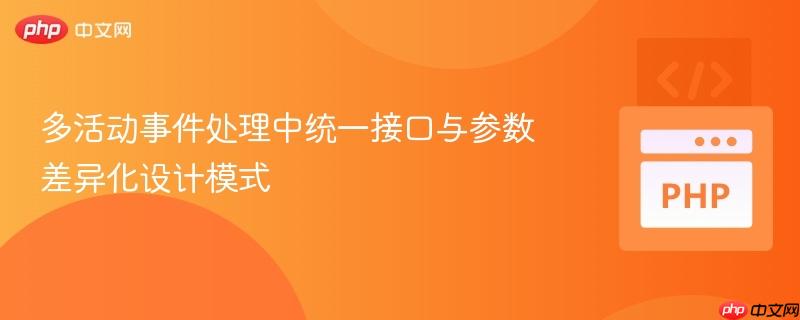
在多个活动需响应相同事件但事件参数各异的场景中,直接使用接口会遇到参数签名不一致的挑战。本文介绍一种设计模式,通过引入事件上下文接口作为参数包装器,使得核心事件接口保持统一,同时允许具体实现类处理不同的参数组合。这种方法有效解决了参数差异化问题,提升了系统的灵活性、可扩展性和可维护性。
在面向对象编程中,我们经常会遇到这样的场景:系统中存在多个“活动”或“模块”(例如不同的营销活动 FirstCampaign, SecondCampaign),它们都需要响应一系列相同的“事件”(例如 onFirstPurchase, onFirstTrade)。然而,这些事件在不同的活动中可能需要处理完全不同的参数列表。例如,FirstCampaign 的 onFirstPurchase 可能需要 ($arg1, $arg2, User $user),而 SecondCampaign 的 onFirstPurchase 可能只需要 (User $user)。
直接使用接口来定义这些事件方法会遇到一个核心问题:接口要求所有实现类的方法签名必须严格一致。这意味着如果 CampaignInterface 定义了 onFirstPurchase(User $user),那么所有实现类都必须遵循这个签名,无法处理额外或不同的参数。
// 假设这样定义接口,但无法满足不同参数签名的需求
interface CampaignInterface {
public function onFirstPurchase(User $user); // 无法为所有活动提供足够的灵活性
public function onFirstTrade(Model $model);
}另一种尝试是使用变长参数(如 onFirstPurchase(...$arguments)),但这会导致方法内部逻辑复杂化,需要手动解析和验证参数类型及数量,降低了代码的可读性和健壮性,且失去了IDE的类型提示优势。
为了优雅地解决这一问题,我们可以采用一种结合了接口隔离原则和策略模式思想的设计模式:引入“上下文接口”作为事件方法的参数包装器。
核心思想是:
这样,事件方法在活动接口中的签名就可以保持稳定,例如 onFirstPurchase(User $user, PurchaseContextInterface $context)。具体的参数差异则由不同的 PurchaseContextInterface 实现类来承载。
这个接口定义了所有活动必须实现的事件方法。关键在于,这些方法不再直接接受原始的、多变的参数,而是接受一个或多个通用对象,其中包含了事件触发时需要的核心实体(如 User)以及一个封装了所有其他特定参数的上下文对象。
<?php
interface User {} // 示例User接口或类
interface Model {} // 示例Model接口或类
interface CampaignInterface {
/**
* 处理首次购买事件。
* @param User $user 触发购买的用户。
* @param PurchaseContextInterface $context 包含购买相关的特定参数。
*/
public function onFirstPurchase(User $user, PurchaseContextInterface $context);
/**
* 处理首次交易事件。
* @param TradeContextInterface $context 包含交易相关的特定参数。
*/
public function onFirstTrade(TradeContextInterface $context);
}
?>为每个事件类型定义一个独立的上下文接口。这些接口规定了上下文对象应提供哪些方法来获取事件相关的特定数据。具体的实现类将根据需要包含不同的属性和方法。
<?php
// 首次购买事件的上下文接口
interface PurchaseContextInterface {
// 可以定义一些通用的获取方法,例如:
// public function getPurchaseAmount(): float;
// public function getProductId(): string;
}
// 首次交易事件的上下文接口
interface TradeContextInterface {
// 可以定义一些通用的获取方法,例如:
// public function getTradePrice(): float;
// public function getTradeModel(): Model;
}
?>这些类将实现 CampaignInterface。在事件方法内部,它们通过接收到的上下文对象来获取所需的特定参数,并执行各自的业务逻辑。
<?php
class FirstCampaign implements CampaignInterface {
public function onFirstPurchase(User $user, PurchaseContextInterface $context) {
// FirstCampaign可能需要arg1, arg2。假设FirstCampaignPurchaseContext提供了这些。
if ($context instanceof FirstCampaignPurchaseContext) {
$arg1 = $context->getArg1();
$arg2 = $context->getArg2();
// ... 使用$user, $arg1, $arg2 进行业务逻辑
echo "FirstCampaign: User purchased with {$arg1}, {$arg2}\n";
} else {
// 处理非预期的上下文类型,或者抛出异常
echo "FirstCampaign: Received unexpected PurchaseContextInterface\n";
}
}
public function onFirstTrade(TradeContextInterface $context) {
if ($context instanceof FirstCampaignTradeContext) {
$price = $context->getPrice();
$something = $context->getSomething();
$model = $context->getModel();
// ... 使用$price, $something, $model 进行业务逻辑
echo "FirstCampaign: User traded with price {$price} and model {$model->getName()}\n";
}
}
}
class SecondCampaign implements CampaignInterface {
public function onFirstPurchase(User $user, PurchaseContextInterface $context) {
// SecondCampaign可能只关心User
echo "SecondCampaign: User purchased\n";
// 如果需要,也可以从context获取额外信息
}
public function onFirstTrade(TradeContextInterface $context) {
if ($context instanceof SecondCampaignTradeContext) {
$model = $context->getModel();
echo "SecondCampaign: User traded with model {$model->getName()}\n";
}
}
}
?>这些类将实现相应的上下文接口,并包含特定于该活动和事件的参数。它们负责存储和提供这些参数。
<?php
// FirstCampaign的首次购买上下文
class FirstCampaignPurchaseContext implements PurchaseContextInterface {
private $arg1;
private $arg2;
public function __construct($arg1, $arg2) {
$this->arg1 = $arg1;
$this->arg2 = $arg2;
}
public function getArg1() { return $this->arg1; }
public function getArg2() { return $this->arg2; }
}
// FirstCampaign的首次交易上下文
class FirstCampaignTradeContext implements TradeContextInterface {
private $price;
private $something;
private Model $model;
public function __construct($price, $something, Model $model) {
$this->price = $price;
$this->something = $something;
$this->model = $model;
}
public function getPrice() { return $this->price; }
public function getSomething() { return $this->something; }
public function getModel(): Model { return $this->model; }
}
// SecondCampaign的首次购买上下文(可能不需要额外参数,但仍需实现接口)
class SecondCampaignPurchaseContext implements PurchaseContextInterface {
// 可以在这里添加SecondCampaign特有的参数
}
// SecondCampaign的首次交易上下文
class SecondCampaignTradeContext implements TradeContextInterface {
private Model $model;
public function __construct(Model $model) {
$this->model = $model;
}
public function getModel(): Model { return $this->model; }
}
// 示例User和Model实现
class ConcreteUser implements User {
private $name;
public function __construct($name) { $this->name = $name; }
public function getName() { return $this->name; }
}
class ConcreteModel implements Model {
private $name;
public function __construct($name) { $this->name = $name; }
public function getName() { return $this->name; }
}
?>当需要在应用程序的不同部分触发事件时,根据当前的活动和事件类型,创建相应的上下文对象并调用。
<?php
// 假设我们有一个事件触发器
function triggerFirstPurchaseEvent(CampaignInterface $campaign, User $user, PurchaseContextInterface $context) {
$campaign->onFirstPurchase($user, $context);
}
function triggerFirstTradeEvent(CampaignInterface $campaign, TradeContextInterface $context) {
$campaign->onFirstTrade($context);
}
// 实例化活动
$firstCampaign = new FirstCampaign();
$secondCampaign = new SecondCampaign();
// 实例化用户和模型
$user1 = new ConcreteUser("Alice");
$modelA = new ConcreteModel("Product A");
$modelB = new ConcreteModel("Product B");
// 触发 FirstCampaign 的首次购买事件
$firstCampaignPurchaseCtx = new FirstCampaignPurchaseContext("promo_code_123", 100.50);
triggerFirstPurchaseEvent($firstCampaign, $user1, $firstCampaignPurchaseCtx);
// 输出: FirstCampaign: User purchased with promo_code_123, 100.5
// 触发 SecondCampaign 的首次购买事件
$secondCampaignPurchaseCtx = new SecondCampaignPurchaseContext(); // 可能不需要额外参数
triggerFirstPurchaseEvent($secondCampaign, $user1, $secondCampaignPurchaseCtx);
// 输出: SecondCampaign: User purchased
// 触发 FirstCampaign 的首次交易事件
$firstCampaignTradeCtx = new FirstCampaignTradeContext(99.99, "extra_data", $modelA);
triggerFirstTradeEvent($firstCampaign, $firstCampaignTradeCtx);
// 输出: FirstCampaign: User traded with price 99.99 and model Product A
// 触发 SecondCampaign 的首次交易事件
$secondCampaignTradeCtx = new SecondCampaignTradeContext($modelB);
triggerFirstTradeEvent($secondCampaign, $secondCampaignTradeCtx);
// 输出: SecondCampaign: User traded with model Product B
?>当面临多个活动需要响应相同事件但事件参数签名各异的挑战时,引入上下文接口作为参数包装器是一种强大而灵活的设计模式。它允许我们在保持核心事件接口统一的同时,优雅地处理参数的差异化需求。通过遵循接口隔离原则和封装变化的思想,这种模式显著提升了系统的可扩展性、可维护性和健壮性,是构建复杂、灵活应用程序的有效工具。
以上就是多活动事件处理中统一接口与参数差异化设计模式的详细内容,更多请关注php中文网其它相关文章!

每个人都需要一台速度更快、更稳定的 PC。随着时间的推移,垃圾文件、旧注册表数据和不必要的后台进程会占用资源并降低性能。幸运的是,许多工具可以让 Windows 保持平稳运行。

Copyright 2014-2025 https://www.php.cn/ All Rights Reserved | php.cn | 湘ICP备2023035733号